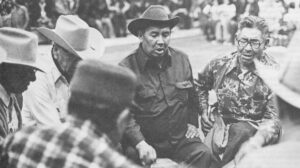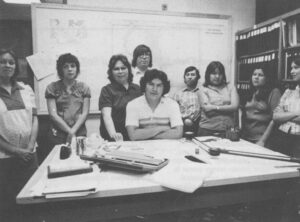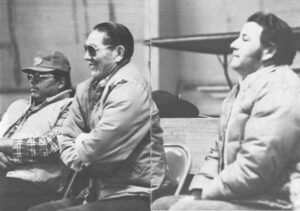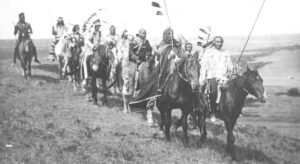LANDER, Wyo.–Five years ago the 25 major energy tribes of the West created the Council of Energy Resource Tribes. With a bravado that soon backfired, the organization compared itself with OPEC, reporting that the tribes owned one-third of the West’s low sulfur coal; one-half of the nation’s privately-owned uranium; and huge reserves of oil, gas and oil shale.
What the tribes really wanted was not cartel powers but equitable financial return and the opportunity to develop or not to develop according to their people’s goals. Besieged daily with development proposals, they lacked the expertise to evaluate them and they lacked confidence in the federal government’s advice, which had betrayed them in the past.
No one ever thought it would be easy to bring together two dozen tribes, who are traditionally wary of each other, of energy corporations, and of the federal government. Nor would it be easy to get federal funding and plunge into tribal development choices involving billions of dollars.
Now, five years later, most tribe members are proud of CERT’s performance, saying the staff of 60-predominantly nonIndians-and their Indian board have boosted the tribes’ management capacity and their image.
However, just when CERT needs solidarity most, one can hear rumbling in the ranks. Four tribes recently withdrew-the Cheyenne River Sioux of South Dakota, convinced CERT would force them to mine their uranium; the Colville Confederated Tribes of Washington, upset with CERT’s abrasive public relations tactics; and the Shoshone and Arapahoe Tribes of the Wind River Reservation in Wyoming, skeptical that CERT had any special expertise to offer.
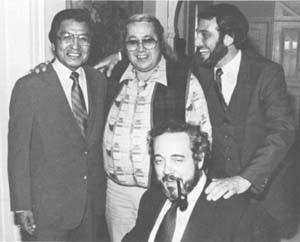
While some representatives of the four tribes have opposed the decisions to withdraw, and other tribes have joined to take their places, the defections hurt. They come at a time when the federal government, which supplies almost all of the organization’s funds, is scrutinizing CERT. The General Accounting Office, which is the investigative arm of Congress, is looking into how CERT spends its money, how effectively it serves Indian energy resource owners, and what other sources of income it has.
According to the critics, CERT has courted controversy, too, through inflammatory comparisons with OPEC, attacks on the Bureau of Indian Affairs, and interference with the nomination of Tom Fredericks as assistant secretary of Interior. Meanwhile it has sidestepped some internal controversies, such as criticism from traditional Indian groups who oppose development, from advocates for individual Indian mineral owners, and from former employees.
With the GAO investigation, CERT is being forced to address some of its problems directly. Whatever the results of the study, such close scrutiny is bound to bring some changes, if only in the Indian board members’ present laissez faire involvement.
A favorite target is CERT’s financial base. Critics of CERT raise philosophical questions of why government funds should be used and ethical and legal questions of how the funds are used.
This year CERT is seeking $2.9 million from four federal agencies and $1 million from member tribes and other contracts. This $3.9 million represents 0.2 percent of the total $1.862 billion Congress appropriated for Indian programs for fiscal 1981.
Critics question whether CERT should depend so heavily upon federal funds, largely because of the effect on its credibility. Since a large share of the money comes from the Department of Energy, some critics and some staff members think CERT is biased toward expediting development of nonrenewable energy, such as fossil fuels and uranium. CERT’s funding proposal to DOE lends credence to this argument since it highlights accomplishments favoring development of synthetic fuels, coal-fired power plants and mines on reservations, sometimes exaggerating their actual likelihood.
Ken Fredericks (Mandan- Hidatsa), national director of real estate for the BIA, and others in the agency believe that giving so much money to CERT limits the Bureau’s ability to fulfill its responsiblity to the tribes. In effect, these critics said, the BIA is transferring its responsibility to serve all energy tribes to the shoulders of a private organization that serves only its members. Fredericks admitted that the BIA, which has been trustee for the Indian resources for 150 years, “obviously” has not carried out that responsibility adequately. But, he said, with more money the BIA could improve.
On the other hand, if the BIA had been providing technical services to the tribes, they would not have needed CERT so much. If it is going to continue to perform this role, the money must come from somewhere. CERT cannot depend upon money from energy companies when it is reviewing contracts and negotiating for tribes, and the tribes don’t have the money now to support CERT.
Some former employees of CERT have suggested giving the federal money directly to the tribes, who could then choose between CERT and other consultants for technical services. However, the tribes generally disagree with this approach. Hugh Baker (Mandan-Hidatsa), director of energy for the Three Affiliated Tribes on the Fort Berthold Reservation in North Dakota, said that CERT has helped the tribes realize the need for comprehensive government planning and has helped to find federal money for it. CERT has also helped to establish energy offices on several reservations which will gradually be taking over many of the functions that CERT now provides. The organization is finding funding for a national training institute for Indian science and business students. But, until such efforts to improve tribal management capacity succeed, CERT tribes believe that they are not ready to live without CERT nor do they feel that the funds should go directly to them rather than to CERT. Ed Gabriel, executive director of CERT, expects CERT tribes to manage their own resources without the organization’s help by 1987. He foresees closing CERT’s Denver technical resource office and maintaining a small lobbying staff in Washington, D.C. funded completely by the tribes. By the end of 1982, 70 percent of CERT employees will be Indian. Now 40 percent are Indian, according to Gabriel.
As for the question of representing energy tribes adequately, Gabriel said CERT tribes control 95 percent of the Indian energy resource base.
But virtually ignored throughout the debate are the individual Indian mineral owners. These individuals, known as allottees, may actually own from 40 percent to 75 percent of the energy CERT is claiming in the northern states, according to recent BIA figures. These allottees inherited land and mineral rights as a result of the General Allotment Act of 1887 when parcels of land were signed over to tribal members. Congress hoped at that time to end the Indians’ special relationship with the federal government. Although the policy was later reversed, more than 80 percent of some northern CERT tribes’ reservations is allotted.
According to the BIA, the tribal councils have no authority to negotiate for minerals on these lands. And as many as 100 may own one 160 acre parcel, making it sometimes impossible for a consensus to be reached on development questions.
Gabriel said CERT gives technical assistance to allottees if their tribal council requests it. However, according to attorney Carol Connor, often there is a conflict of interest between the tribe and the individual if, for instance, they own adjacent lands and differ on whether to mine coal. A member of the Assiniboine Tribe from the Fort Peck Reservation in Montana and an attorney, she often represents her tribe at CERT board meetings. She believes the CERT staff is ignoring the allottee question. “We don’t need to destroy the people in order to save the tribes,” she said.
Gabriel, however, said his staff is glad to serve allottees and even tribes who do not belong to CERT upon request. “How can we turn them down when their only option is going through the BIA?” Gabriel asked.
Such a job at the BIA is typical of CERT’s attitude, and the feeling is mutual. The animosity between the two has created problems for some tribes, who must work with both. Ernie Clark, a councilman for the Colville Tribes in Washington, said he thinks CERT is needed, and he doesn’t want to hurt the organization. However, his tribe withdrew from CERT because of the group’s pubic statements attacking the BIA and comparing CERT with OPEC. “It looked too much like propaganda,” he said.
BIA officials’ resentment of CERT seems to be partly a reaction to CERT’s attitude, partly a genuine concern for tribes who are not members, and partly jealousy of CERT’s accomplishments.

One of the CERT board members, Caleb Shields (Sioux) of the Fort Peck Tribal Council in Montana said, “In three years, CERT has established a better track record than the whole history of the BIA.”
In 1977, about the same time that CERT opened its offices, the BIA decided to open a minerals technical assistance center in Denver. Three years later, in January 1981, only five people had been hired. Because of federal funding limitations and the uncertainty caused by the change in administration, 12 positions were still unfulfilled.
In the same amount of time, CERT had developed a staff of about 40 at its technical assistance center in Denver, including many people with doctoral or masters degrees in natural sciences or economics, as well as extensive industrial and government experience.
While the BIA center staff said it takes about a year before they can respond to a request for a mineral inventory, CERT claims its staff can begin work within six weeks on an average major project. On at least one occasion, a tribe has turned to CERT for help interpreting a BIA mineral inventory.
Defending CERT, Rick Stone, assistant to former Secretary of Energy Charles Duncan, said CERT has helped tribes get millions of dollars. “The money goes to those who produce good paper describing what they want to do. The paper CERT has produced on behalf of the tribes has been of consistently good quality,” he said.
Gabriel said CERT has leveraged $17 million in loans and grants from federal agencies and private industry that would not have otherwise been available.
Beyond the question of where CERT’s money comes from are questions of how it is spent. Five former staff members-Paul Epley, Barbara Nagel, Bill Roberts, Bill
Nagle, and Mahmood Rana, who worked for CERT in 1978 and 1979-feel the organization was squandering public funds. They asked not to be identified individually.
They told of a three day staff retreat held at the Keystone resort in Colorado in 1979 where little work was accomplished, but meals and lodging in condominiums were provided for staff and at least one spouse. They said when Gabriel came to Denver for meetings, he frequently stayed at the Brown Palace, an exclusive luxury hotel.
In reply, Gabriel said the retreats were management training seminars, that the Washington staff who attended were in Denver for other business, too, and that a banking institution contributed $3,300 to cover the lodging, meals and conference rooms.
CERT abides by federal per diem limitations on food and lodging, Gabriel said, even though it is not legally required to do so. He does sometimes stay at the Brown Palace and other luxury hotels across the country, he said, adding, “It’s my lifestyle… But I pay the difference out of my pocket.”
The five former staff members are bitter. All hired by the same man, who was forced to resign later, they gave up more lucrative jobs to work for CERT. They criticized CERT’s performance, partly because they think CERT should do more to expedite energy development. They were excited about the prospect of being involved in the development of the biggest unexploited reserves in the country and upset that CERT advocated an ” anti-corporate attitude” among the tribes. “They told the tribes that every company in the United States was trying to rip them offl,” one said.
They said that when their technical reports were reviewed by non-scientists on the Washington, D,Cstaff, they were changed to “justify certain preconceived notions” before being given to the tribes.
One said that as a scientist, he was upset when CERT distorted facts for political purposes. Figures on the size of tribal resources are “grossly exaggerated,” he said, since many are not commercially attractive or won’t be developed for philosophical reasons.
A staff member from one of the CERT tribes, who asked not to be identified, said the biggest problem is that tribes are given the illusion that they are competing with industry’s expertise on equal ground. While he feels CERT has produced some very excellent work, at times the CERT staff seemed to him to be ignorant of certain facts, and other times they seemed to be deliberately manipulating the tribe.
However, representatives of most of the CERT tribes who were contacted had not noticed such problems. Of the 10 tribes contacted, six expressed unequivocal satisfaction with the technical assistance they had received.
Cheyenne River Sioux energy director Joe Troisi, a non-Indian, said he was very satisfied with CERT’s help preparing a draft oil and gas agreement. He thinks the organization fills a vital role. His tribal council might not have withdrawn from CERT if the members had consulted with Troisi, who was one of the two official representatives to CERT board meetings from the reservation. While the tribal council thought CERT was trying to force them to develop their uranium, Troisi said it was not. In fact, the tribe doesn’t have a developable reserve of uranium, he said.
Troisi found CERT less helpful on a geothermal project, saying the staff has more expertise in oil, gas, coal and uranium. However, he thinks this bias is understandable since the tribes, who feel pressure from the BIA and the energy companies, have emphasized management of nonrenewable resources.
The Hopi Tribe, one of the country’s largest resource owners, has been an inactive member of CERT. Hopi Chairman Abbott Sekaquaptewa said the tribe will continue its membership-if it can avoid getting “locked into a CERT development plan” and still have CERT technical services on request. However, he is concerned that the organization is being used by a couple of Indian leaders for political leverage against the federal government.
The Assiniboine-Sioux Tribes of the Fort Peck Reservation in Montana considered withdrawing from CERT following an article in a national Indian newspaper saying the organization was not accountable to the tribes. The full board of tribal chairmen meets less than twice a year, and resolutions pass with little or no discussion. Most of the tribal chairmen do not get deeply involved because they are responsible first to the priorities of their constituents on the reservations. The executive committee of seven board members meets only four times a year and talks occasionally by conference calls.
As an example of the organization overstepping the board’s direction, sources in several agencies and congressional offices claim that CERT helped block the confirmation of Tom Fredericks (Mandan-Hidatsa) as assistant secretary of Interior for Indian affairs although at least five of CERT’s members had endorsed Fredericks’ nomination. The confirmation was blocked until the presidential election when it became moot because President-elect Ronald Reagan was expected to appoint someone else. While Gabriel has been feuding with Fredericks for years, he swears “on a stack of Bibles” that neither the CERT staff nor the board interfered.
Rather than withdrawing from CERT, Caleb Shields said Fort Peck decided to get more deeply involved and attack any problems within the organization directly. He thinks CERT needs to communicate better with tribal councils and with other Indian organizations, such as the group of traditional Indians who staged a protest at the 1979 board meeting in Phoenix, Arizona, and were not allowed to address the board. As Shields expected, CERT has avoided a recurrence of this embarrassing incident by scheduling subsequent board meetings in Washington, D.C., and New York City-far from the CERT reservations. “You can never resolve anything by ignoring it,” he said.
Hugh Baker of the Fort Berthold Reservation said that tribal involvement is the best way to make the organization work. “People who have problems with CERT should think of the concept behind forming it. I continually remind the CERT staff, ‘You’re here to put yourselves out of business by teaching me. When we get rich on oil and gas, maybe you can come work for us. Until then, help us get rich.’”
“Some tribes are losing sight of why CERT was set up. They think of CERT as another desk of the Department of Energy. You can’t just hand over an assignment and forget it. Your responsibility is to stay on it, to learn,” he said.
While the tribal members of CERT realize the organization has problems, they were not looking for a savior on a white steed who would help them live happily ever after. They were seeking better advice than they were getting from the BIA and less biased help than they could expect from the industry.
The tribes hope the GAO investigation won’t turn into an excuse to eliminate CERT’s funding but instead will be used to make constructive changes if necessary.
©1981 Marjane Ambler
Marjane Ambler is investigating “Indian Energy Policies and Their Effect on Tribal Self-Sufficiency.”

